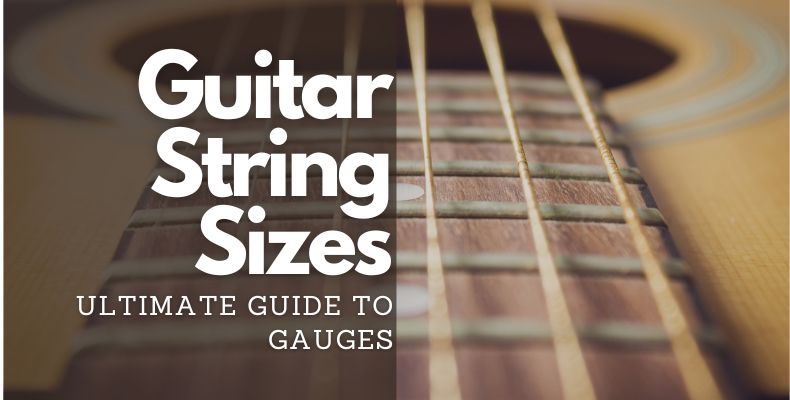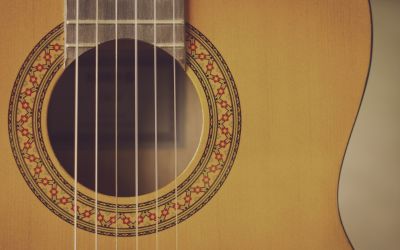Guitar String Sizes: Ultimate Guide To Gauges (2025)

Guitar string sizes, or gauges, play a crucial role in shaping the tone and playability of a guitar. Measured in thousandths of inches, these sizes directly impact the player’s experience and the instrument’s output.
KEY TAKEAWAYS
Whether a beginner or a professional musician, understanding the guitar string sizes can help you make informed decisions regarding your string selection.
Guitar String Sizes
The assortment of string sizes can range from light to heavy gauges. Lighter gauge strings are easier to play, produce a brighter sound, and strain the guitar’s neck less.
Heavier gauge strings generate a warmer, fuller tone but require more finger strength to play and can exert extra tension on the instrument.
Many electric guitarists, for example, might prefer a .010 – .0496 set for balanced tension and sound.
I regularly play guitar in my song production sessions, and the gauge of the strings I choose depends on the guitar. The gauge affects the feel and tone of the guitar, so I choose whichever gauge best fits the particular guitar in question.
In addition to the impact on tone and playability, string gauge can also affect elements such as bending, fretting, and sustain. Players must consider various factors such as playing style, desired sound, and the type of guitar when choosing the right strings.
With many options available, understanding and experimenting with different guitar string sizes is key to enhancing one’s overall musical experience.
Types of Guitars and Strings
Acoustic Guitars

Acoustic guitars are designed to produce sound without the need for amplification. They typically feature steel strings made from various materials such as brass, phosphor bronze, and compound strings. Acoustic guitar string gauges are typically heavier than those used for electric guitars.
Brass, aka bronze or 80/20 bronze strings, consists of 80% copper and 20% zinc, giving a bright, clean sound. Phosphor bronze strings provide warmth and richness, while compound strings offer a balanced sound, combining brass and phosphor bronze characteristics.
Electric Guitars

Electric guitars rely on pickups and external amplification for sound production. They use different steel strings, often denoted by their gauge (thickness). Common gauges include 9s, 10s, and so on.
A lighter gauge string is easier to play, brighter in tone, and allows for easier string bending and fretting. It also exerts less tension on the guitar’s neck. Guitar pickups also heavily influence the tone, for example single coils, P90s and humbucker pickups all have their own unique tones.
The string core metal affects tone and tension strength; heavier string gauges require stronger core metals to prevent premature breakage.
In addition to the string gauge, the types of pickups also affect the guitar’s tone; for example, Fender Stratocaster single coil pickups will sound very different from guitars with P90 pickups.
Classical Guitars

Classical guitars, known as nylon-string guitars, are traditional instruments often used to play classical and flamenco music.
They feature nylon strings instead of steel strings found in acoustic and electric guitars. The three main types of nylon strings are:
- Clear strings: their glossy, transparent appearance gives a brighter sound.
- Rectified strings: less glossy than clear strings, they go through a refining process for better intonation and a mellower tone.
- Carbon strings: manufactured from carbon fiber instead of nylon, they produce a fuller, louder sound with more projection and brightness.
Ukuleles also have typically nylon strings.
Each type of guitar and its corresponding string types offer unique playing experiences and sounds, making them well-suited to different genres and personal preferences.
String Gauges and Tension
Guitar strings come in various gauges, which are measurements of their thickness. The gauge of a string greatly influences its tension, playability, and sound. This section will discuss the characteristics of light, medium, and heavy gauge strings.
Light Gauges
Light strings, also known as lighter gauges, typically have less tension when compared to heavier strings. This makes them easier to play, particularly for beginners or players with weaker fingers. Examples of light gauge sets include 9-42 and 10-46. Lighter strings offer the following advantages:
- Easy bending and vibrato
- Reduced finger fatigue
- Less stress on the guitar’s neck
However, there are some drawbacks to light gauges:
- Prone to breakage
- Less sustain and volume
- Possible fret buzz due to insufficient tension
Medium Gauges
Medium gauge strings are a middle ground between light and heavy strings. They offer a balanced tension, which provides a good mix of playability and tone. Examples of medium gauge sets are 11-49 and 11-52. Benefits of medium gauges include:
- Versatile sound suitable for various genres
- Better sustain and volume than light strings
- Less prone to breakage
The potential downsides of medium gauges are:
- Increased finger fatigue compared to light strings
- Slightly more difficult bends and vibrato
Heavy Gauges
Heavy strings, also called heavier gauge strings or heavy strings, have a higher tension than lighter strings. They are often favored by players who prefer a fuller, richer tone or play in lower tunings. Examples of heavy gauge sets are 12-56 and 13-62. The advantages of heavy gauges are:
- Rich sound with more sustain and volume
- Suitable for lower tunings
- Less prone to breakage
On the flip side, heavy gauge strings have some drawbacks:
- Increased finger fatigue
- More difficult bending and vibrato
- Potential need for guitar setup adjustments
In conclusion, choosing the right string gauge depends on individual preferences, playing styles, and desired sound. Experimenting with string gauges can help you discover what works best for you and your guitar.
Guitar String Sizes and Materials
Thickness and Diameter
Guitar strings come in various thicknesses, or gauges, measured in thousandths of an inch. The high E string (thinnest string) usually ranges from .008 to .012 inches, while the low E string (thickest string) ranges from around .038 to .056 inches. Here’s a general classification of gauges:
- Extra Light: High E around .008-.009 inches
- Light: High E around .010-.011 inches
- Medium: High E around .012 inches
- Heavy: High E .013 inches and above
Thicker strings typically provide a richer and deeper sound, while thinner strings offer easier playability and a brighter tone. The choice of string thickness depends on factors such as playing style, musical genre, and personal preference.
String Materials
There are several materials used to construct guitar strings, with the following being the most common for electric and acoustic guitars:

Stainless Steel
These strings are known for their durability and bright, crisp tone. They are commonly used by electric guitar players who want a clear, responsive sound.

Phosphor Bronze
Frequently used for acoustic guitars, phosphor bronze strings produce a warm and balanced tone. They are recommended for fingerpicking and smooth, mellow playing styles.

Nickel-Plated Steel
A popular choice for electric guitar players, nickel-plated steel strings combine steel’s durability with nickel’s warmth and smoothness.
The choice of string material can significantly impact the tone and playability of a guitar. Musicians should experiment with various materials and gauges to find the combination that best suits their skill level, playing style, and preferences.
Selecting the Right String Gauge
Playing Style and Genre
Selecting the right string gauge depends on your playing style and the genre of music you perform. Different string gauges cater to specific playing techniques and musical styles.
For example, if you often bend notes, a lighter gauge may be a good idea, as it requires less effort to bend the strings. On the other hand, heavier gauges complement hard strumming or lower tunings common in heavier music genres.
Light gauge strings are suitable for:
- Fingerstyle playing
- Light strumming
- Jazz
Medium gauge strings are versatile and work well for:
- Rock
- Blues
- Country
Heavy gauge strings are ideal for:
- Heavy metal
- Drop tunings
- Strong strumming
Skill Level
Skill level also plays a crucial role in choosing the right string gauge. Beginner guitarists might find starting with lighter gauge strings easier as they apply less tension on the fingers, making pressing the strings down to the fretboard easier.
Moreover, lighter strings are more forgiving and allow beginners to develop proper playing techniques without experiencing too much pain or discomfort.
Many guitar books geared towards beginners cover also the topic of string choices.
As you progress in your guitar journey, you can experiment with heavier gauges to find the perfect balance between tone, playability, and personal preferences.
More experienced players often develop preferences for certain string gauges based on their unique playing styles and the genres they prefer.
Consider your playing style, genre, and skill level when selecting the right string gauge for your guitar. Experimenting with different gauges will help you find the perfect one that enhances your playing experience and elevates your overall musicianship.
Famous Guitarists and Their String Choices
Jimi Hendrix
Jimi Hendrix is known for his revolutionary guitar techniques and unique sound. One of the secrets to his distinct approach, he used light gauge strings. Hendrix typically used .010-.038 sets, which enabled him to perform his signature bends and solos effortlessly.
Stevie Ray Vaughan
Stevie Ray Vaughan also had a specific choice of guitar strings that significantly contributed to his signature blues sound. He preferred heavy gauge strings, usually .013-.058 sets, which allowed him to produce strong, powerful tones.
The thick strings enabled Vaughan to apply heavier picking and a more aggressive playing style.
James Hetfield
James Hetfield, Metallica’s rhythm guitarist, and vocalist, employed a heavier gauge string set to achieve the powerful, driving sound synonymous with the band. He generally used .011-.058 sets on his electric guitars, which provided extra tension for drop tunings often used in metal music.
John Petrucci
John Petrucci, the virtuoso guitarist of the progressive metal band Dream Theater, is recognized for his technical prowess and precision. Petrucci utilized mixed string sets, combining heavy and light gauges, with his preference being .010-.052 sets.
These strings allowed him to balance his intricate lead playing and heavy riffing.
Jimmy Page
Jimmy Page, the iconic guitarist of Led Zeppelin, was known for employing various string gauges throughout his career, depending on his musical needs. He often used .009-.042 sets, facilitating his smooth, agile playing style and easy bends.
In conclusion, famous guitarists’ choice of guitar strings can be attributed to their desired playing style, genre, and tone. No one-size-fits-all solution exists, as each guitarist prefers to achieve their unique sound.
String Maintenance and Change
Proper string maintenance is essential for any guitarist to achieve optimal playability and sound quality. String change should occur regularly, as a fresh set of strings can significantly improve the tone and intonation of the instrument.
Over time, guitar strings may lose their brightness due to the buildup of dirt, sweat, dead skin, and oils from the fingers. This can cause the guitar to sound dull and become difficult to play.
A regular string change can help maintain the guitar’s tone and make playing more enjoyable. Additionally, new strings stay in tune better and are less prone to breakages.
Following a process that ensures a consistent and smooth experience is essential when changing guitar strings. Firstly, one should loosen each string and carefully remove them, starting with the lowest E string.
Afterward, the guitarist should clean the fretboard, bridge, and headstock to remove any accumulated dirt or debris.
When selecting a new set of strings, the guitarist should consider their preferred size and gauge to match their desired tone and playability. Once the new strings are chosen, it’s crucial to properly attach them to the guitar, starting with the low E string.
The process involves securing the string at the bridge and winding it around the tuning pegs, creating a stable and secure connection.
While changing strings, it’s a good opportunity to check the truss rod and correct any deviations in the guitar’s neck curve. The truss rod is a metal bar that runs through the guitar neck, providing stability and adjustability.
If the neck is not in the correct position, it can cause intonation issues and negatively affect the instrument’s playability. One should consult a professional or refer to the manufacturer’s guidelines for proper truss rod adjustments.
In summary, maintaining and regularly changing guitar strings is vital for achieving the instrument’s best tone and playability. Guitarists can ensure their instrument is in optimal condition by thoroughly checking the truss rod during string changes.
Understanding String Product Differences
String Manufacturers
When it comes to guitar strings, different manufacturers produce strings with unique characteristics. Some popular string manufacturers include Ernie Ball, D’Addario, Elixir, and Martin.
Each brand offers a variety of string sets, addressing different preferences, playing styles, and musical genres. It’s essential to understand the differences between these brands and choose the one that best matches your personal preferences and instrument needs.
Guitar strings have evolved with the latest technology developments in music. Many of the above mentioned companies can now manufacture better and longer lasting strings that bring out the best tones from your guitar. I recommend testing out different sets from various manufacturers to find your favorite strings that best suit your playing style and tone.
String Sets
Guitar string sets are composed of individual strings that vary in thickness and material. Typically, sets include six strings, with thickness denoted by the term “gauge.” The common gauges range from extra light to heavy in varying measurements.
A key distinction between string sets is the core type. Guitar strings typically feature a steel core with either a hexagonal or round shape. The two primary core types in modern strings are round and hex core.
Each type has its own set of sonic characteristics. Round core strings generally offer a warmer and smoother tone, while hex core strings provide better overall tuning stability and a brighter sound.
Another essential aspect of string sets is the string winding. The most common type is the roundwound variety, featuring a round-shaped wire wrapped around the core.
Roundwound strings are known for their bright and punchy tone, making them suitable for various musical genres.
Here are some popular string sets:
| Manufacturer | Core Type | String Winding |
|---|---|---|
| Ernie Ball | Round core | Roundwound |
| D’Addario | Hex core | Roundwound |
| Elixir | Hex core | Assorted (Different coatings) |
| Martin | Hex core | Roundwound |
Finally, each string in a set has a ball end, which sits in the guitar’s bridge or tailpiece and holds the string in place. The construction and quality of ball ends vary between manufacturers, influencing the strings’ longevity and tone.
Understanding the differences between string manufacturers and string sets is crucial for guitarists to make informed decisions about their instrument setup. By considering factors such as core type, winding, and ball ends, you can choose the best strings for your playing style and desired tone.
Factors to Consider When Choosing Guitar Strings
When selecting the right guitar strings, there are several factors to consider. The choice of guitar strings will significantly impact playability, tone, and overall sound.
To make an informed decision, consider factors such as tension, tone, string gauges, personal preferences, and the type of guitar being played.
Firstly, consider the tension of the strings. Less tension generally makes it easier to press the strings down, reducing the strain on the fingers. This can be particularly helpful for beginners or those with hand issues.
On the other hand, higher tension strings offer more resistance and can provide better tone and sustain. However, they may require more finger strength and effort to play.
Different string gauges play a key role in determining the tension and tone of the guitar. Generally, lighter gauge strings (e.g., 9’s) have less tension, making them easier to play, but may sacrifice some tone quality.
Conversely, heavier gauge strings (e.g., 11’s or 12’s) have higher tension, producing a fuller and richer tone, but may require more effort to press down. As a general rule, electric guitar players may prefer lighter gauges, while acoustic guitar players may opt for heavier gauges.
Ultimately, personal preference should be a driving force in choosing guitar strings. Players should experiment with various string gauges and materials to determine which combination best suits their playing style, skill level, and desired sound.
Remember that there is no strict rule of thumb for selecting the perfect strings, as each guitarist’s preferences and needs may vary.
Furthermore, consider the type of guitar being played. Different guitars require different string sets, and using the wrong strings can result in poor performance or harm the instrument. Always ensure that the chosen strings are suitable for the specific guitar model.
In summary, selecting the right guitar strings requires considering factors such as tension, tone, string gauges, personal preferences, and the type of guitar being played.
Considering these aspects, you can make informed decisions and tailor your instruments to your unique needs and preferences.
Frequently Asked Questions
What are the most common electric guitar string gauges?
The most common electric guitar string gauges typically range from .009 inches to .011 inches for the high E string. These sets are often referred to as 9’s or 11’s, respectively.
The other strings in the set will have increasing thicknesses, with the low E string being the thickest.
How do acoustic guitar string sizes differ from electric?
Acoustic guitar string sizes differ from electric guitar strings in material and thickness. Acoustic strings are thicker and made from bronze or phosphor-bronze, while electric guitar strings are usually made from nickel or steel.
The thicker strings on an acoustic guitar produce a louder, warmer tone, suitable for the resonant sound desired in acoustic music.
Which gauge of strings is best for different playing styles?
The choice of string gauge can depend on the player’s preferred playing style. Lighter gauge strings, like .009s, are more comfortable for beginners and allow easier bending and vibrato.
Heavier gauge strings, like .011s or higher, provide more tension and are suitable for players who employ aggressive picking techniques or play in lower tunings. A balanced set can offer a compromise between playability and tone.
How do I choose the right string size for my guitar?
Choosing the right string size for your guitar depends on various factors, including personal preference, guitar type, and playing style. Experimenting with different string gauges can help you find the perfect fit for your needs.
When deciding on string size, it’s also essential to consider factors such as the guitar’s scale length, bridge type, and setup.
What are the benefits of using heavier or lighter gauge strings?
Heavier gauge strings offer increased sustain, volume, and a more focused tone due to their higher tension. They can also be suitable for alternative tunings and aggressive playing styles.
Lighter gauge strings, on the other hand, provide ease of playability and more comfortable bending for lead guitarists. They can also produce a brighter tone, which might be preferred in certain music genres.
Are there specific string gauges for different genres of music?
While string gauges can be a matter of personal preference, certain genres of music might benefit from specific string gauges.
For example, jazz guitarists often prefer heavier gauge strings for a warm, smooth tone, while rock or blues players might opt for lighter gauge strings for easier bending and a brighter sound.
Ultimately, the choice of string gauge should be based on the desired tone and feel that suits your musical preferences and playing style.
Conclusion
There are many different guitar types and gauges of strings that cater to acoustic and electric guitars’ unique needs.
The thickness of the string, often referred to as the gauge, plays a significant role in how a guitar plays and sounds.
Thin strings are often a great choice for beginners due to their ease of playability, while heavier set strings offer a different tone, often preferred by those who play heavier styles of music.
The most important factor to consider is how the guitar string gauges align with your personal style of playing. For instance, lower strings with a larger diameter, often found in standard gauges, might be a big deal for many players who prefer a fuller, richer sound.
High strings with high tension might be more suitable for those who play for long periods and require their strings to maintain their tone over time.
In thinner string sets, the g string often breaks first as it gets hit harder as a side effect as you play the lower strings. It’s a crucial part of the guitar’s setup. If you break the g string often, I suggest a higher gauge string set. Its size and tension can significantly impact the overall sound and playability of the instrument. Similarly, the diameter of a string can affect its tone and how long it lasts.
Extra heavy strings, while not the best way for beginners, can offer a different tone and feel that some advanced players might prefer. The string gauges can also affect the standard tuning of a guitar, with different sizes offering a range of tuning stability.
In the end, the best acoustic guitar strings or electric strings for you will depend on various factors, including your playing style, desired tone, and the specific needs of your instrument.
Experimenting with different types of strings can be rewarding, helping you find the perfect set that makes your guitar sing.





